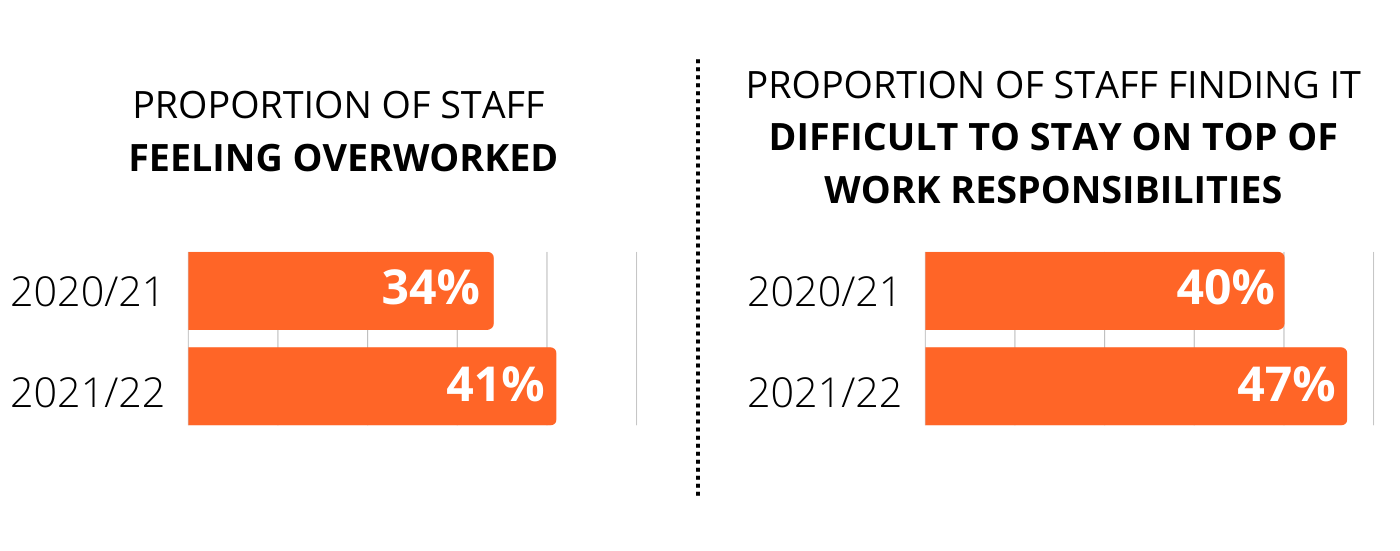8 December, 2022
Great resignation
Staff retention affects education beyond being a financial challenge, particularly in the context of the ‘great resignation’.
The Great Resignation: The Effects on Schools and Trusts
Staff turnover and retention are significant problems for school and Trust leaders. We have previously looked at the current economic climate and the cost of living crisis effect on staff wellbeing and retention. This blog looks at how staff retention can affect schools and trusts beyond being a financial and recruitment challenge. We also look at ways trusts and schools can measure hidden impacts of staff turnover during the ‘Great Resignation’.
Why Are We Talking about Staff Retention?
The latest statistics from the UK government’s Staff Workforce Census show that in 2020/21, the number of teachers leaving their roles jumped by 12.4 per cent, with just over 36,000 people leaving their roles within education, 4000 more than the previous year. This statistic is significant as 36,000 members of staff represent 8.1% of all teachers leaving the state-funded sector.
Let’s look specifically at the percentage of teachers in our Staff Wellbeing survey saying they are considering resigning and the percentage of the teachers actually leaving the workforce. There is a direct match in trends between the government’s data set and our survey data.
Overall, the number of staff of all roles considering resigning increased from 34% in the 2020/21 academic year to a four-year record survey high of 42% in 2021/22.
Carver-Thomas, D. & Darling-Hammond, L. from the Learning Policy Institute and Karla Wang from Science of Learning suggest that some staff turnover can benefit schools and trusts. For instance, turnover can enhance teacher workforce quality by bringing in new ideas and improving pupils’ learning experience. However, we are currently seeing nearly 10% of teachers leaving, with schools struggling to recruit teachers to fulfil existing positions due to the market being flooded with vacancies.
The ‘Great Resignation’ has been at the forefront of the recruitment and economic news for the last few months. The TUC has recently suggested that there could be a possible “mass exodus” of staff if support and cost of living proofed pay rises aren’t prioritised.
Whilst the numbers are still lower than the pre-pandemic resignation rate of 42,100 leavers in 2018, it shows an increase that could continue to grow this year. As discussed in our previous blog on the cost-of-living crisis, the increased living costs and below-inflation pay rises could contribute to a possible future increase in staff resignations within education.
Our Staff Wellbeing Survey can help you predict an issue before it becomes one. With the ‘Great Resignation’ still a prominent issue, it is crucial to understand the effects of staff retention and ways to improve it.
Effects of the 'Great Resignation' on Schools and Trusts
Increasing staff turnover during the ‘Great Resignation’ and the ‘cost of living crisis’ is a challenge on its own, requiring schools and trusts to conduct constant recruitment. A growing deficit of new teachers makes recruitment more challenging for school leaders to fill existing vacancies, let alone replace staff. However, the impact of higher staff turnover goes beyond an increased need for hiring and training new staff, affecting continuity of learning, parent-school relationships, and school/trust culture, to name a few.
Continuity of Learning
The importance of continuity in students’ education is widely argued to be a pillar of education. “Continuity is concerned with ways in which the education system structures experience and provides sufficient challenge and progress for pupils in a recognisable curricular landscape.” One aspect of the current education climate that affects students’ continuity is staff retention and turnover.
Bristol University recently discussed the importance of solid staff retention and developing policies to increase teacher retention. Their article states, “Although teacher turnover may be beneficial in some cases, we find that, on average, turnover is detrimental to student learning. When teachers leave schools at high rates, student learning drops.”
The effects of teacher turnover on pupils’ outcomes have been widely debated in recent years (particularly in the context of the ‘Great Resignation’), with teacher retention becoming a prominent story in the media. A recent study found there was a correlation between teacher turnover and outcome gradings at the end of formal education, suggesting that to ensure our schools and trusts offer students the best opportunities to learn and excel, we must also consider school staff retention as a contributor to this, and prioritise staff wellbeing and retention just as much as the quality of delivery.
Staff retention goes a long way to ensure that standards are consistently maintained. A particular stage of education where parents value continuity is over the two years when GCSEs are taught. Mark also highlights that these two years particularly benefit from higher staff retention levels, with pupils more likely to achieve with more consistent staffing. A lower staff turnover during these years also improves parents’ perceptions of the school/trust.
Parental Engagement
One of the effects commonly perceived by parents is disrupted learning and lower achieved attainment. Mark Steed, at TES Magazine, sums up the effect of staff turnover on relationships and trust with parents. Mark highlights the continuity of teaching as something that parents understandably see as essential; he also highlights that parents value consistent standards from year to year.
Teachers’ understanding of pupils isn’t learnt overnight or read and understood from teacher handover notes. Teacher continuity ensures that pupils learning experiences are kept consistent, and new relationships aren’t having to be built over. There are suggestions within the sector that a school’s reputation amongst the parent community and the local community can be significantly affected by the perceived levels of staff retention; TES also highlight that school reputation is particularly affected if the perceived turnover amongst senior leadership teams is high as parents see a change in leadership positions to be particularly disturbing to the continuity of learning within the school.
School/Trust Culture
Whilst consistency of staff and continuity of learning is documented as crucial indicators for student performance, there is also evidence to suggest that staff turnover can be a leading contributor to school/ trust culture and workplace environment challenges.
Whilst poor staff retention can incur high costs to schools and Trusts, it can also impact staff workload and the development of strong team relationships. High staff turnover can be a barrier to developing a strong team culture, especially in the context of the ‘Great Resignation’. Continuity in teams allows staff to build strong working relationships with colleagues, which can be highly beneficial to overall staff wellbeing.
Lower staff retention and challenging recruitment can lead to smaller, more short-staffed teams. With smaller teams, workloads become even more stretched, and teacher burnout becomes more prevalent. With 41% of staff feeling overworked in 2021/22 compared with 34% in 2020/21, it is evident that teacher workload is growing as a problem within the sector. Over time smaller teams and the understaffed school can result in higher stress levels and the wellbeing of the whole school team being impacted.
Our new Culture-driven recruitment handbook can help schools look to improve overall culture through hiring and retaining staff members who can positively impact the organisation. The handbook shows you how to understand your existing organisational culture, use that to attract the right staff, and develop them in a way that creates a virtuous cycle of higher retention of the staff who can have the highest impact in your organisation.
Ways to Explore Staff Retention and Its Impact During the 'Great Resignation'
At Edurio, we work with school and trust leaders around the country to improve the experience for staff, pupils and parents. At the heart of our work is a belief that by understanding your current situation in context, you can see where you need to go next to improve outcomes for all associated with your organisation.
The impact of staff turnover can be measured in more ways than just pupil outcomes. Pupil Wellbeing surveys, Staff Wellbeing surveys, and Parent Experience surveys can all offer insights into some of the factors we have mentioned within this blog, such as continuity of learning, school & Trust Culture, staff workload, workplace environment and parental perceptions. Collecting first-hand responses through surveys for all school stakeholders can be a vital data collection tool to explore stakeholders’ experiences of your schools or schools within your trust.
As the effect of teacher turnover is becoming more of a focal point due to increasing staff resignations (including mid-term resignations), many school leaders and trust leaders are looking for ways in which they can keep their finger on the pulse with staff wellbeing and experience by using a variety of leadership tools available to them. There are many ways to measure staff wellbeing; most start with opening up the conversation. School surveys – staff check-ins – pulse surveys – are excellent ways to monitor and overcome possible catalysts for staff retention.
If you are interested in learning more, we would be happy to schedule a video call to demonstrate the Edurio platform and discuss the Staff Wellbeing Survey in more detail. During the call (30-45 minutes) you will:
- have a look at the survey questions,
- get to know the data collection process,
- experience Edurio results exploration,
- receive answers to any additional questions you may have.




